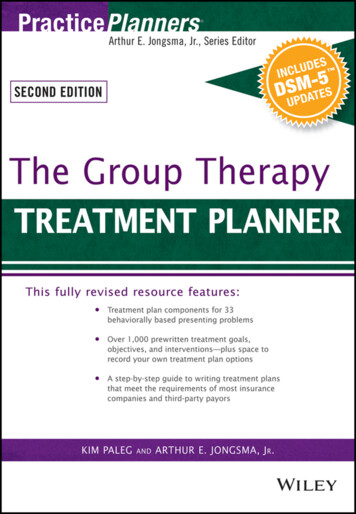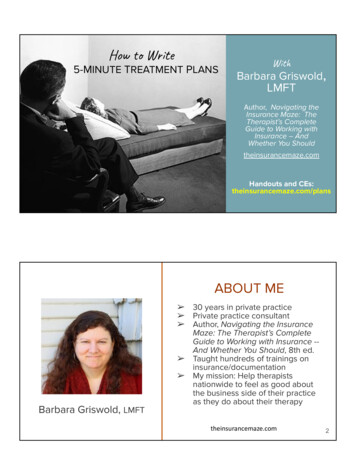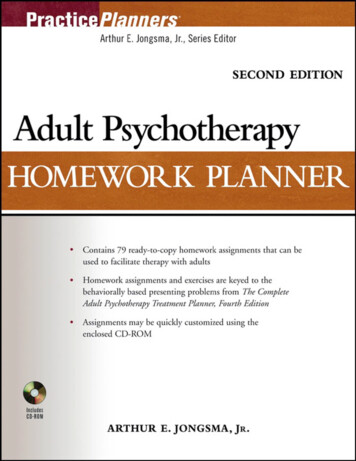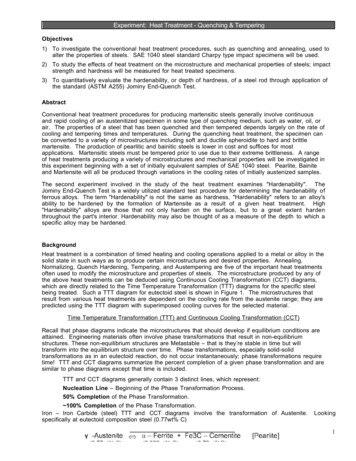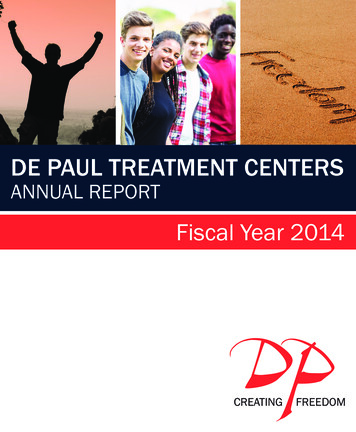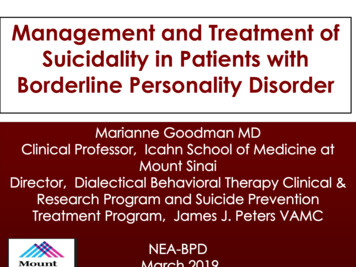
Transcription
Management and Treatment ofSuicidality in Patients withBorderline Personality Disorder
2Big Clinical Questions in the care of suicidalindividuals with BPD 1. How do I identify which of my BPD patients are athighest risk to kill themselves? How do I identify the potential completers from the“chronic attempters”? 2. How do I best manage “high” suicide risk? What is the role of “no harm” contracts?Hospitalization? medication? 3. How do I protect myself from being sued? 4. How do I handle the death of a patient fromsuicide?
1. How do I identify which of my3BPD patients are at highest risk to killthemselves?Predicting Suicide in BPD
Suicide completers and attempters4are clinically distinct groupsBPD SuicidecompletersBPD lent methods Non-violentmethodsCluster B comorbidity(ASPD)yesNoSubstanceyesNodependenceBPD Suicide completers- who are they?*Most successful suicides occur on the first attempt* associated with heightened levels of impulsivity, hostilityand co-morbid cluster B antisocial personality disorder(ASPD), drugs
What else do we know about whichpatients with BPD successfullysuicide? Longitudinal studies note: suicide completions occurred after age 30, later in the course of the illness,after unsuccessful treatment effortswhen the patient is alone andnot involved in active treatment. despite multiple threats, younger females with BPD intreatment are at low risk of death by suicide.refs: Paris 2004, Stone, 1990.
6Summary- Identifying Suicide Risk Risk factors for suicide attempts in BPD differ from riskfactors for suicide completion. Many first-time attempters have a lethal outcome. Better identification and understanding of theseindividuals, most of whom are not in clinical care, isa priority as is further clarifying which 10% of theattempters will progress to completion over thecourse of their illness.
2. How do I best manage “high”suicide risk?The Role of “No Harm” Contracts The APA guidelines advocate for the judicious use of thetherapeutic alliance to negotiate safety with skilled clinicians but caution about using the contact as a substitute for a rigoroussuicide evaluation of the patient. Others* believe that "no-harm" contracts can be useful curtail the patient from using suicidal behaviors as a means ofcommunication with the therapist, clarify expectations and help prevent treatment sabotaging behaviors. Other expert's opinions caution that "no-harm" contracting shouldbe done in the context of an established therapeutic connectionwith regular follow-up and detailed documentation. All recommendation regarding no-harm contracts are expertopinions as minimal empirical evidence exists.* refs: Hopko, et al, 2003.
Suicide Safety Planning1) The Suicide Prevention Resource Center(http://www.sprc.org) has designated the Suicide SafetyPlan (SSP) as a ‘best practice”2) The Safety Plan instructs one to: recognize personal warning signs of suicide; use internal coping strategies; engage social contacts that can offer support and serve asdistraction from suicidal thought; contact family members or friends who may help resolve acrisis; provide contact information for professionals to help Keep environment safe3) It can be a stand-alone interventionStanley & Brown, 2008
NY Office of Mental HealthSuicide Safety Plan Mobile App
Additional Apps: ReliefLink &Virtual Hope BoxDeveloped by Nadine Kasnow, PhD10Developed by Nigel Bush, PhD
Role of Hospitalization for Chronic11Suicidality in BPDHospitalizationPROS: Supported by APA Practice Guidelines for SuicidalBehaviorKeep patients safeAppropriate for treatment of Co-morbid Axis I exacerbations,diagnostic questions, medication adjustmentsCONS: biggest critics (Paris, Linehan, Dawson and MacMilian)Minimal evidence exists supporting hospitalization/unproveneffect“little more that a suicide watch”Can result in negative consequences such as- behavioralregression, reinforce behaviors clinicians are trying to limit
Hospitalization forSuicidality in BPD Controversial! Our recommendations serves as an integration: prudent use of hospitalization. If admission is necessary, keep it brief Managed care's pressure for shortened hospital stays hasinadvertently benefited hospitalized suicidal individuals withBPD.* Vijay and Links (2007);Goodman et al, 2012
Psychotherapy and Suicide cont.All the efficacious psychotherapies forsuicide teach patients how to:1) manage suicidal urges,2) reduce the reinforcements of selfdestructive behavior3) maintain the integrity/structure ofthe treatment in spite of crisis. (Weinberg et al, 2010)
Psychotherapy and Suicide14 Evidence base of psychotherapy approaches include: cognitivebehavior therapy (CBT), Collaborative Assessment andManagement of Suicide (CAMS), dialectical behavioral therapy(DBT). Yet need for the development of briefer and less resource intensetreatment Systems Training for Emotional Predictability and Problem Solving(STEPSS) program Stanley's brief DBTReferences:CBT: Brown et al, 2005; Rudd et al, 2004;2015. CAMS: Jobes et al, 2009; 2012.DBT: Linehan, 1993; new manual 2014;Stanley et al., 2007.STEPPS Blum et al, 2008.
Pharmacological/biological agentshelpful in reducing suicide riskEmpirical data exists for several agents, but none specific forsuicide in BPD.1. Clozapine is the first FDA approved anti-suicide indicationfor schizophrenia. quetiapine 300-600mg has been reported to be effective inreducing suicidal ideation in bipolar depression2. Lithium in bipolar disorder evidence of a 5 fold decrease in risk of suicideattempts in bipolar disorder & reduced suicidal lethality in the attemptsthat occurred. Effects seen after a year of treatment3. SSRIs. Previous concerns about black box warnings. Newrecommendations are to use but monitor for increases in agitation,akathesia and suicidal ideation.Refs: quetiapine- Thase et al, 2006; Calabrese et al, 2005; lithium- Baldessariniet al, 2006.
Pharmacological/biological agentshelpful in reducing suicide risk cont.These two agents helpful for “acute” suicidal ideation4. ECT. Helpful in reducing suicidal urges quickly in inptsetting.5. Ketamine. A glutamate N-methly-D-aspartate (NMDA)receptor antagonist. Expanding interest. Helpful in refractory MDD IV infusion with rapid resolution of suicidal thinking lastingfew days. Unclear effects of longer term use, addiction potential?References: ECT- Kellner et al, 2005; Ketamine- Price et al, 2014
3. How do I protect myself from beingsued? Fear of litigation can inappropriately influence clinicaldecision making. In a group of clinicians working with adult BPD patients, 80%admitted that within the last year, they had practiced in amanner that was not likely to be in their patients’ best interest,but would protect them from medicolegal repercussions.(Krawita & Btacheler, 2006),2006.
“professionally indicated short-termrisk-taking” Thorough assessment and risk assessment documented chronic pattern of suicidality and/or self-harm. well-documented comprehensive treatment plan. A longitudinal risk assessment and risk-benefit analysis must be carefullydeveloped, individualized, documented and regularly reviewed alongwith the treatment plan. importance of documenting the reasons why the specific plan wasselected and considered to be the best means of minimizing risk to thepatient. Additionally, obtaining second opinions and consultation are oftenuseful also must be well-documented. It is also important to include the patient directly in this process andfamily/peers/etc in establishing the plan documentation of patient and family agreement and understandingis similarly essential.Krawitz et al, 2004
4. How do I handle the death of apatient from suicide? Death of a patient by suicide is adevastating and unnerving experience 50% risk of losing a pt to suicide duringone's career. 38% of psychiatrists who lose a pt tosuicide experience extreme distress.Best to seek consultation and supportshould it occur.Chemtob et al, 1988;Hendin et al, 2004.
RESOURCES For residents (or any clinician) who loses a patientto x20
Expert Opinion on Treatment ofSuicide21 Great Britain's National Institute of Heath, ClinicalExperience (NICE) guidelines (2009) conclude that medications should not be used specifically for BPD orthe behaviors associated with the disorder and instead advocate for astructured and integrated clinical approach to BPD, comment on the lack of appropriately trained clinicians in theseinterventions.
Resources cont.Expert Opinion on Treatment ofSuicideAPA guidelinesfor the Assessment and Treatmentof Patients with Suicidal Behavior (2003)provide specific indications for psychiatric. hospitalization for suicide riskand advocate particular agents to target components of suicide risk.Practice Parameter for the Assessment andTreatment of Children and Adolescents WithSuicidal Behavior (2001)Specific recommendations regarding risk &treatment guidelines, But outdated.
THANK YOU FOR YOUR ATTENTION!Contact information:Marianne Goodman MDIcahn School of Medicine at MountSinaiJames J. Peters (Bronx) VA MedicalCenter718-584-9000 ext 5188Marianne.goodman@va.gov
and co-morbid cluster B antisocial personality disorder (ASPD), drugs . What else do we know about which patients with BPD successfully suicide? Longitudinal studiesnote: suicide completions occu





